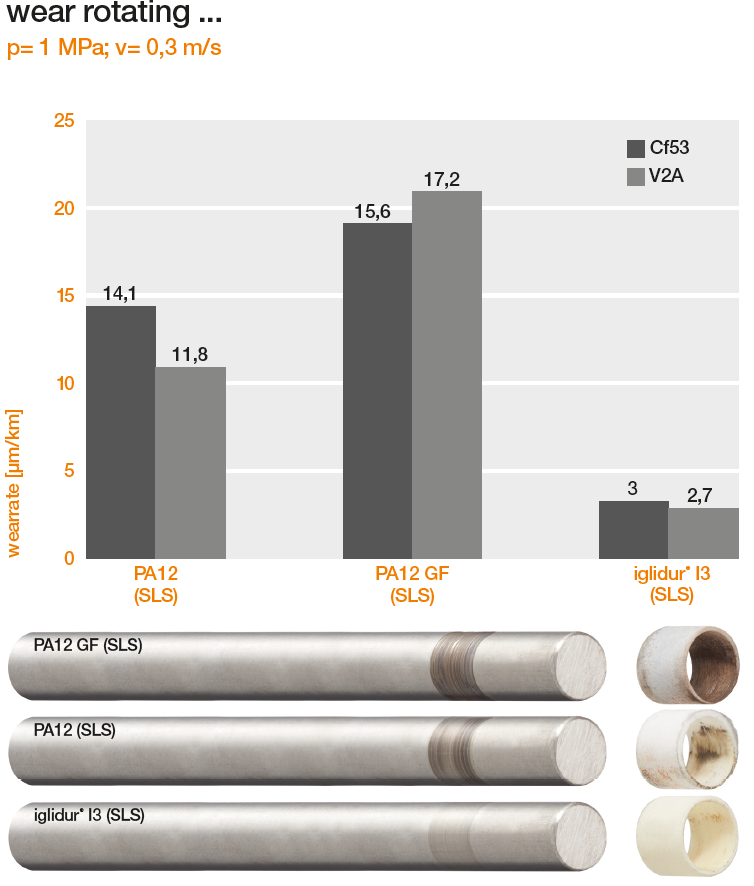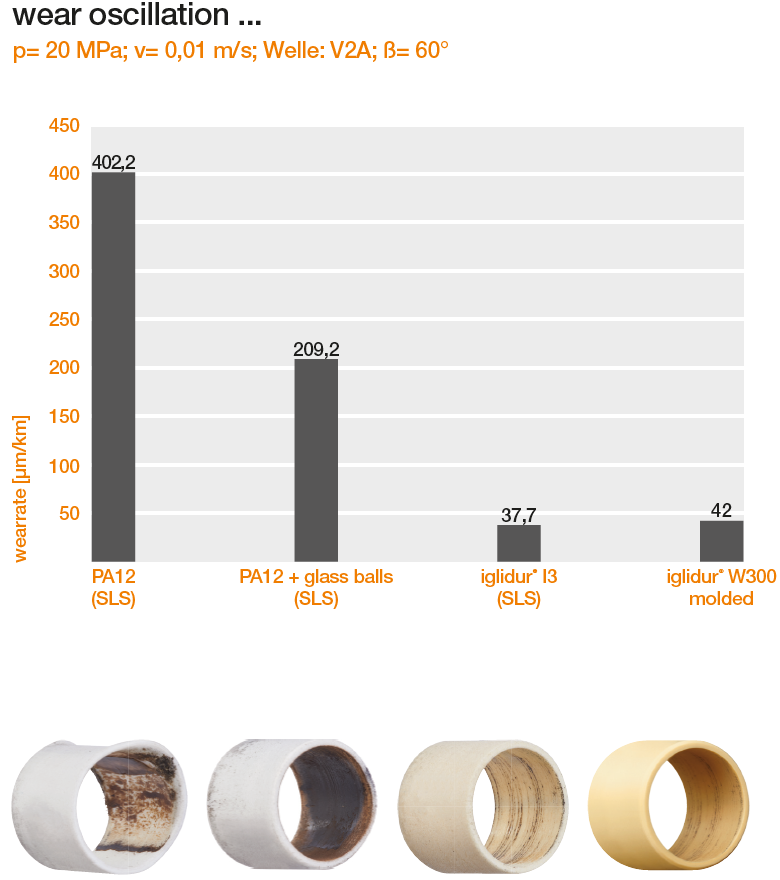3D printing with wear-resistant polymers
Niklas Eutebach | 24. April 2020
3D printing is ascendant across industries and materials, not only in product development, but also in industrial manufacturing processes. But if the freedom granted by additive manufacturing is to realise its full potential in the industrial environment, 3D printing materials must perform just as well as their mechanically processed counterparts. igus has dedicated itself to this task in the area of technical high-performance polymers and focuses on developing filaments and laser sintering polymers for the construction of low-friction, wear-resistant industrial-grade components.
What does “wear resistance” mean for mechanical components?
Wear resistance is a material’s ability to resist abrasion in a number of different load states. Let’s take the classic case of a plain bearing: a shaft turns or slides in the bearing under a certain load and at a certain speed. Wear on the contact surface in this case means an increase in bearing diameter, the creation of residue, and other undesirable effects that ultimately cause the bearing, and thus the machine, to fail. But it can also cause wear on the shaft, which is usually more difficult and expensive to repair or replace than the bearing is.

With this in mind, our material development is focused on improving the material’s wear resistance as much as possible. And, of course, the term “wear” can be expanded to include similar conditions in other moving applications: sliders, linear bearings, gears, lead screw nuts, thrust washers, grippers, and many more.
Why is wear resistance important for 3D printing?
Because 3D printing has come to be used not only for prototype construction, but also for manufacturing final application parts in industrial applications, 3D printing materials must exhibit the same properties as materials that have previously been used for conventional manufacturing technology. This applies to all material properties: mechanical, thermal, electrical, etc. For our customers, who have relied on high-performance igus polymers for years, wear resistance and coefficient of friction are the most important properties, and this remains true for the selection of 3D printing material.
To ensure a smooth transition from prototyping to volume production, several of the proven technical iglidur polymers are available as 3D printing material, bar stock, and injection moulding material. In all these forms, they exhibit similar tribological properties, which is a great advantage for product development.
Less wear on wear-resistant parts
iglidur materials were originally developed for use in bearings and in all types of components that allow low-wear, lubricant-free movement (which is where our “motion plastics” slogan comes from). iglidur 3D printing materials are typically used for assemblies that are subjected to all types of motion (rotary, swivelling, gliding, etc.) – and iglidur materials make them much more durable than standard construction materials would be. Judging by the parts that are ordered from our 3D printing service, many customers benefit from igus material properties in the manufacture of tailored gears. Depending on size and complexity, mechanical manufacture of gears is much more expensive and complicated. Our experiments have also shown that standard plastic gears made of POM, wear several times faster than 3D printed iglidur gears.
Cross-industry advantages of wear-resistant 3D printing materials
Many branches of industry use iglidur materials – either to improve a technological aspect of an application (reduce maintenance effort by eliminating the necessity of regular lubrication, for instance) or to reduce serial production costs (or, ideally, both). Key industries are the automotive, food and packaging industries, machine and system production and energy generation. But since almost any machine can be improved with wear-resistant components, and igus regularly develops new materials for special requirements (ESD, food-grade, flame-retardant, etc.), more and more industries are discovering the benefits of wear-resistant polymers in additive manufacturing. For instance, iglidur filaments are used across industries for prototype and/or small-batch production.
Inspect, test, compare – the long road to outstanding coefficient of wear
igus operates a large laboratory with special equipment to measure all the promised properties of injection moulded parts, bar stock and 3D printing material. Long-term tests on special equipment are used to determine wear, reproducing the load scenarios outlined above (pressure, speed, temperature, etc.). We also test iglidur materials for a number of different partner materials – various types of steel, aluminium, polymer and ceramics.
The data generated is available via online tools such as our “bearing expert”, test reports (in the appendix for the product in question), wear tests, and other documentation; it can be queried directly for a specific application.

Wear is measured in µm/km: micrometres of abrasion wear over kilometres of travel on the contact surfaces. This information allows customers and our technical customer advisors to calculate a part’s estimated service life in use. As a general rule, service life depends on application parameters such as material pairing (steel, aluminium, polymers), pressure (force per calculated unit of load-bearing surface), surface speed (metres per second on the the sliding surface), movement type (swivelling, rotating, linear), and other conditions such as temperature and environment.
No lubrication, no problem
Wear of mechanically loaded parts greatly increases in the absence of lubrication. This is why a metal ball bearing that can run for miles (literally and figuratively) can fail quickly if the correct lubrication procedure is not used. So how is it that igus’s 3D printing materials and products can be “lubricant-free”? – The incorporation of solid lubricants into the polymer eliminates the need for additional lubrication. This delivers a number of advantages such as lower wear, better sliding properties, greatly reduced maintenance costs and cleaner machines (no more greasy fingers on machines with which users must interact).
Sound too good to be true? You can test the properties of 3D printed iglidur components yourself – we would be happy to send you our sample box.
